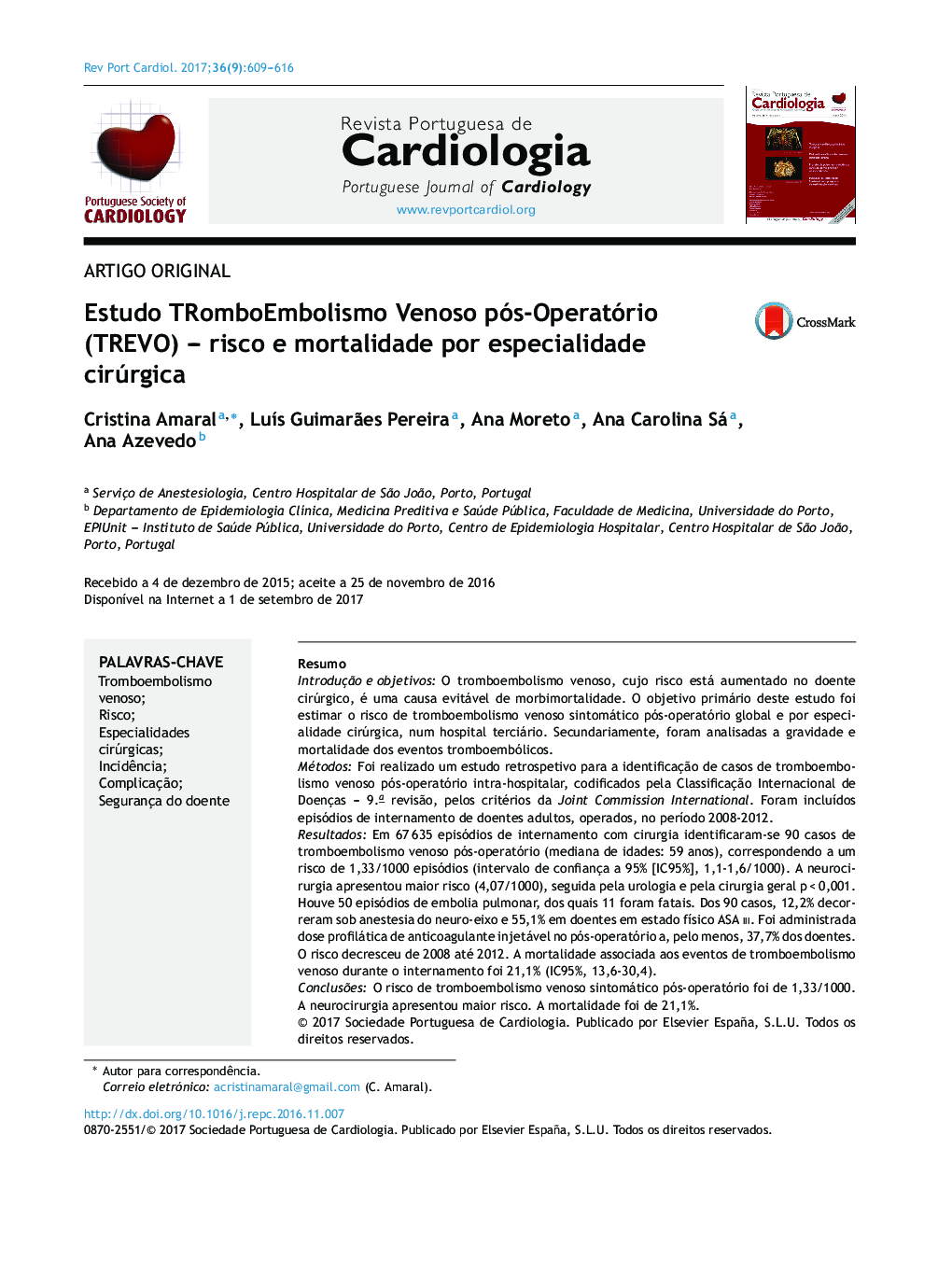| Article ID | Journal | Published Year | Pages | File Type |
|---|---|---|---|---|
| 5126379 | Revista Portuguesa de Cardiologia | 2017 | 8 Pages |
ResumoIntrodução e objetivosO tromboembolismo venoso, cujo risco está aumentado no doente cirúrgico, é uma causa evitável de morbimortalidade. O objetivo primário deste estudo foi estimar o risco de tromboembolismo venoso sintomático pósâoperatório global e por especialidade cirúrgica, num hospital terciário. Secundariamente, foram analisadas a gravidade e mortalidade dos eventos tromboembólicos.MétodosFoi realizado um estudo retrospetivo para a identificação de casos de tromboembolismo venoso pósâoperatório intraâhospitalar, codificados pela Classificação Internacional de Doenças - 9.ª revisão, pelos critérios da Joint Commission International. Foram incluÃdos episódios de internamento de doentes adultos, operados, no perÃodo 2008â2012.ResultadosEm 67 635 episódios de internamento com cirurgia identificaramâse 90 casos de tromboembolismo venoso pósâoperatório (mediana de idades: 59 anos), correspondendo a um risco de 1,33/1000 episódios (intervalo de confiança a 95% [IC95%], 1,1â1,6/1000). A neurocirurgia apresentou maior risco (4,07/1000), seguida pela urologia e pela cirurgia geral p < 0,001. Houve 50 episódios de embolia pulmonar, dos quais 11 foram fatais. Dos 90 casos, 12,2% decorreram sob anestesia do neuroâeixo e 55,1% em doentes em estado fÃsico ASA III. Foi administrada dose profilática de anticoagulante injetável no pósâoperatório a, pelo menos, 37,7% dos doentes. O risco decresceu de 2008 até 2012. A mortalidade associada aos eventos de tromboembolismo venoso durante o internamento foi 21,1% (IC95%, 13,6â30,4).ConclusõesO risco de tromboembolismo venoso sintomático pósâoperatório foi de 1,33/1000. A neurocirurgia apresentou maior risco. A mortalidade foi de 21,1%.
Introduction and ObjectivesVenous thromboembolism, risk of which is increased in surgical patients, is a preventable cause of morbidity and death. The primary objective of this study was to estimate the incidence of symptomatic postoperative venous thromboembolism in adults at a tertiary university hospital, overall and by surgical specialty. The secondary objective was to analyze severity of and mortality from thromboembolic events.MethodsWe performed a retrospective study to identify cases of inâhospital postoperative venous thromboembolism, encoded by the International Classification of Diseases, Ninth Revision, according to the Joint Commission International criteria. Adult patients admitted for surgery in 2008â2012 were included.ResultsAmong 67 635 hospitalizations, 90 cases of postoperative symptomatic venous thromboembolism were identified, corresponding to an incidence of 1.33/1000 admissions (95% confidence interval [CI] 1.1â1.6/1000). Neurosurgery had the highest risk (4.07/1000), followed by urological surgery and general surgery (p<0.001). There were 50 cases of pulmonary embolism, 11 of which were fatal. Of the 90 cases, 12.2% occurred under neuraxial anesthesia and 55.1% in patients with American Society of Anesthesiology III physical status. At least 37.7% of patients with events received a prophylactic dose of injectable anticoagulant postoperatively. The overall risk decreased from 2008 to 2012. Venous thromboembolismâassociated mortality during hospitalization was 21.1% (95% CI 13.6â30.4).ConclusionsThe incidence of postoperative symptomatic venous thromboembolism was 1.33/1000. Neurosurgery showed the greatest risk. Mortality was 21.1%.
